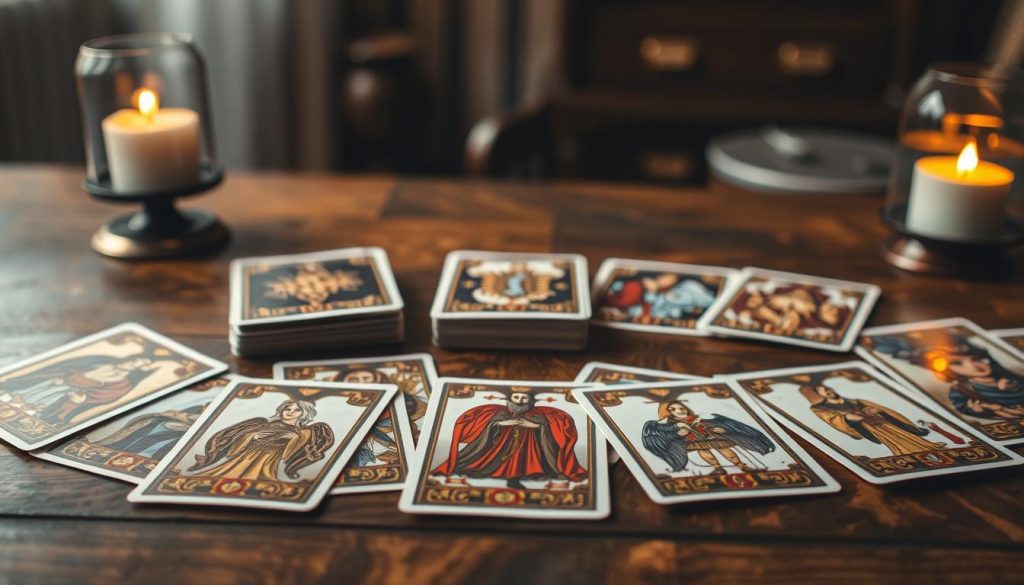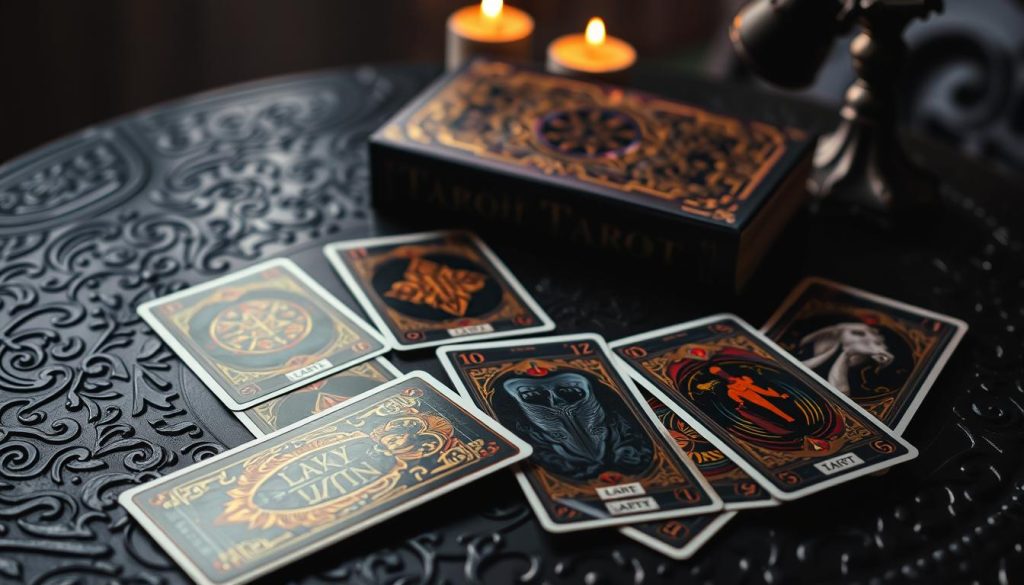Welcome. We treat tarot as a modern mirror for mind and heart. This 78-card system helps with intuition and self-reflection, not fixed fortune-telling. Many beginners find Rider‑Waite imagery helpful because the pictures guide meaning.
We’ll set a calm vibe and show a clear way forward: choose a deck, bond with it, learn meanings without overwhelm, then practice simple readings. Small rituals fit busy schedules and keep energy balanced.
Daily habits matter. One-card draws, quick notes in a tarot journal, and pattern spotting turn minutes into real progress. Decks and spreads are tools, not rules — if an image tugs at your intuition, follow that spark.
We pair classic imagery with gentle structure, and we’ll guide a first full reading you can repeat. Expect playful, grounded steps that blend ancient wisdom with modern digital helpers.
Tarot, Not Fortune-Telling: What It Is and How It Works Today
Think of tarot as a conversation with your unconscious, gently revealing patterns. Modern practice treats tarot as psychological and intuitive. Authors like Benebell Wen and Brigit Esselmont frame it as a tool that opens intuition and inner wisdom.
We use card images as symbolic language that reflects mind and energy. Readings surface subconscious thoughts, fears, and wishes. They show likely outcomes without sealing your life path.
Dark cards aren’t doom. They mirror inner processes so you can work through them with compassion. We lean into intuition as the engine—your inner voice links imagery to what’s really on your mind.
Ask open-ended questions: What patterns are at play? What energy supports me? Watch how cards talk to each other; context shifts meaning fast. Keep a journal each day to compare notes and grow your understanding.
This way, tarot becomes part of modern well-being—self-inquiry, clearer choices, and more agency in daily life.

Choosing Your First Tarot Deck the Right Way
Picking the right deck feels more like meeting a friend than making a purchase. Handle sample decks in bookstores or metaphysical shops when you can. If travel isn’t possible, browse online galleries and YouTube flip-throughs to see every card.
Notice which artwork lights you up. That nudge is your intuition. Many love the Rider‑Waite deck for its clear, story-rich scenes, but you must choose the deck you actually want to use.
Check the guidebook preview and card finish. Card size, cardstock, and texture matter for daily shuffling. Small comforts keep you coming back and help you start reading sooner.
Shortlist a few options, watch detailed videos, then follow the pull. Printable tarot deck files can be a budget-friendly thing that gets you started fast. In the end, pick the deck you’ll reach for every day — that’s how progress happens.

Get to Know Your Tarot Deck Before You Dive In
Before you lay out a spread, spend time eyeing each card and letting small details land in your mind. We unbox with intention. Flip through every card slowly and note first impressions: color, symbols, and emotion.
Many decks include a booklet with keywords, and some have full companion books that explain art choices. Read the booklet so the artwork’s story helps the meaning land in memory.
Pick one tarot card a day. Journal what you see and feel. Then compare your impression with a concise meaning summary. This practice makes what each card means stick without overwhelm.
Notice recurring symbols — water, mountains, hands, animals — and watch how they shift a card’s message. Try a short ritual: shuffle, breathe, and ask the deck, “What do I need to learn with you today?”

Keep the deck nearby for a week — on your desk or altar — so your subconscious bonds with its imagery. Learning a deck is a joyful conversation that deepens with each touch.
Learning Card Meanings Without Memorization Overload
Start small: pull one card a day or two if you feel brave. Name three visual details, then write the short story those images suggest. This keeps learning gentle and steady.
We use a simple loop: trust your first impression, then check a concise meaning. That comparison builds real understanding without rote memorizing. Over time, you’ll notice what cards mean in context.
Think of the deck as vocabulary. Learn single card images first, then let pairs form phrases. Rider‑Waite scenes help you read tarot by picture so you don’t have to memorize long lists of keywords.
Keep tiny sessions—ten minutes a day. Journal wins and misses. Practice 1–2 card draws for a week, then add a third card when you feel steady. This gradual build keeps practice playful.
Try a mini-glossary: note suit themes, number moods, and upright versus reversed tones. Repeat “learn read tarot” skills regularly and trust your intuition to highlight the one thing each card wants to tell you today.

Daily Habits That Build Skill Fast
Make a tiny daily ritual: one card, one breath, one fresh observation. We start the day with a calm pull and hold the image for sixty seconds. Then we jot a single sentence about the theme that shows up.
Evening follow-ups close the loop. A quick note about how the day matched the card trains practical accuracy. Over weeks, repeating cards reveal patterns and layered lessons on your tarot journey.
Keep time short. Two to five minutes fits most days. On weekends we pull three cards to map past, present, and next steps. That wider view helps balance daily detail with bigger energy shifts.
Track “stalker” cards—those that pop up often. They point to lessons you are ready to meet. Use breathwork, gentle sounds, or a timer before draws to steady focus.
Pin your journal or app to your home screen so a reading is one tap away. Keep the practice light and curious. If you miss a day, we simply pick up the thread and keep going—this is how the started tarot journey deepens.
Shuffling, Pulling Cards, and Beginner-Friendly Spreads
Let your hands find a shuffle that feels good; presence matters more than method. We riffle, overhand, or fan the deck. The key is a calm rhythm that keeps you present and connected with the cards.
Pulling cards is simple: spread and pick, draw what calls, or accept jumpers that fall out. Notice which card warms your palm or catches your eye. That small body cue is important for intuition.
Try a Four-Card Check-In: one signifier (Major Arcana), then physical, mental/emotional, and spiritual cards (Minor Arcana). Place them left to right so the order reads like a gentle story.
A classic three-card spread (past–present–next step) works well for short readings. Repeat 1–3 spreads until one fits your style. Treat spreads as frameworks, not rules—rename positions or swap cards until it feels like yours.
Watch for jumpers as a playful nudge and note subtle energy shifts when pulling. For beginners, less analysis and more trust lets meanings open naturally.
How to Read Tarot Like a Pro: Step-by-Step Beginner’s Guide
Start by naming what you need know and breathe—this anchors the whole process. Say a brief intention such as “Show me what I need know for my highest good,” then take three slow breaths.
Ask open-ended questions that invite insight rather than yes/no walls. Keep the wording simple and curious. This clear frame helps any reading land with more meaning.
Shuffle, cut, and pull with the same gentle rhythm each time. Notice the images first: who faces whom, what rises, what falls. Then peek at concise meanings to refine impressions.
We link cards by suit, number, and repeating themes. Write two short lines in a journal: core insight and one suggested action. Close by stating one sentence of integration: “Today I will…”
Revisit the draw in 3–7 days to check results. This small, repeatable practice helps you start reading with steady confidence and lets the deck do its quiet work.
Your First Full Reading: A Simple, Repeatable Process
Let’s walk through one clear, repeatable spread that feels friendly and useful. We use a four-card check-in: a Major Arcana signifier, then three cards for body, mind, and spirit. This layout gives quick clarity and stays easy to repeat.
Begin with intention. Ask, “What do I need know about this situation right now?” Shuffle and pick a Major as your signifier. Place it left, then lay three cards in tidy order: physical, mental/emotional, spiritual.
Scan trends in the spread. Many Pentacles point toward money or material life. Lots of Wands call attention to action and drive. Reversals often signal inner blocks or delay, not doom.
Write a two-sentence summary and one next action that fits your week. Add an example line in your journal: “If I see many fives, I’ll prepare for change with extra flexibility.” Set a reminder to revisit this first tarot reading in seven days.
Repeat the same order next time so skill compounds. Compare this spread with daily readings and note how themes echo across decks and days. Over time, these readings teach you practical patterns for life and choice in the world.
Keep Going: Patience, Practice, and Trusting Your Tarot Journey
Let practice be gentle and regular—this journey grows with tiny, repeated actions.
Give yourself time and steady draws. Try Majors first if a smaller scope helps, then widen as you want learn more.
Honor your energy with short sessions that fit life and work. One card most days, a bit more on weekends, keeps skill alive without burnout.
Celebrate small wins. Noticing one new symbol is a big thing and often changes a lot of readings.
Accept off-days with grace. Keep curiosity; swap decks or spreads when you feel stuck and reflect monthly on growth in your tarot journey.
We’re in this world together — keep the practice playful and trust the time.
New to Tarot or leveling up? Begin with our Tarot guides and spreads: https://mysticbolt.com/category/tarot/ . Next, build focus with Self-Hypnosis & Mind Training: https://mysticbolt.com/category/self-hypnosis-mind-training/ . Align your visuals and intentions in Manifestation & Visualization: https://mysticbolt.com/category/manifestation-visualization/ . Decode timing and signs with Numerology & Angel Numbers: https://mysticbolt.com/category/numerology-angel-numbers/ . Try quick interactive tools in Mystical Fun & Free Apps: https://mysticbolt.com/category/mystical-fun-free-apps/ .
